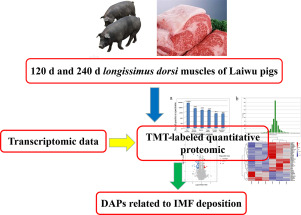当前位置:
X-MOL 学术
›
J. Proteomics
›
论文详情
Our official English website, www.x-mol.net, welcomes your
feedback! (Note: you will need to create a separate account there.)
TMT-labeled quantitative proteomic analyses on the longissimus dorsi to identify the proteins underlying intramuscular fat content in pigs.
Journal of Proteomics ( IF 2.8 ) Pub Date : 2019-12-24 , DOI: 10.1016/j.jprot.2019.103630 Cai Ma 1 , Wenwen Wang 1 , Yuding Wang 2 , Yi Sun 1 , Li Kang 1 , Qin Zhang 1 , Yunliang Jiang 1
Journal of Proteomics ( IF 2.8 ) Pub Date : 2019-12-24 , DOI: 10.1016/j.jprot.2019.103630 Cai Ma 1 , Wenwen Wang 1 , Yuding Wang 2 , Yi Sun 1 , Li Kang 1 , Qin Zhang 1 , Yunliang Jiang 1
Affiliation

|
The Laiwu pig is famous for its excessively extremely high level of intramuscular fat content (IMF), however, the exact regulatory mechanism underlying intramuscular fat deposition in skeletal muscle is still unknown. As an economically important trait in pigs, IMF is controlled by multiple genes and biological pathways. In this study, we performed an integrated transcriptome-assisted TMT-labeled quantitative proteomic analysis of the longissimus dorsi (LD) muscle in Laiwu pigs at the fastest IMF deposition stage and identified 5074 unique proteins and 52 differentially abundant proteins (DAPs) (>1.5-fold cutoff, p < .05). These DAPs were hierarchically clustered in the LD muscle over two developmental stages from 120 d to 240 d. A comparison between transcriptomic (mRNA) and proteomic data revealed two differentially expressed genes corresponding to the DAPs. Changes in the levels of the nine proteins were further analyzed using RT-qPCR and parallel reaction monitoring (PRM). The proteins identified in this study could serve as candidates for elucidating the molecular mechanism of IMF deposition in pigs. SIGNIFICANCE: The intramuscular fat content (IMF) refers to the amount of fat within muscles and plays an important role in meat quality by affecting meat quality-related traits, such as tenderness, juiciness and flavor. Using the integrated transcriptome-assisted TMT-labeled quantitative proteomic approach to characterize changes in the proteomic profile of the longissimus dorsi muscle, we identified differentially abundant proteins, such as ALDH1B1, OTX2, AnxA6 and Zfp512, that are associated with intramuscular fat deposition and fat biosynthesis in pigs. These proteins could serve as candidates for elucidating the molecular mechanism of IMF deposition in pigs.
中文翻译:

TMT标记的背最长肌上的定量蛋白质组学分析可鉴定猪肌肉内脂肪含量的蛋白质。
莱芜猪以其肌肉内脂肪含量(IMF)过高而闻名,但是,骨骼肌中肌肉内脂肪沉积的确切调控机制仍是未知的。作为猪的一项重要经济性状,IMF受多种基因和生物途径控制。在这项研究中,我们对IMF沉积最快的莱芜猪背最长肌(LD)肌肉进行了转录组辅助的TMT标记的定量蛋白质组分析,并鉴定了5074种独特蛋白质和52种差异丰富蛋白质(DAP)(> 1.5倍截止,p <.05)。这些DAPs在120 d至240 d的两个发育阶段中分层聚集在LD肌肉中。转录组(mRNA)和蛋白质组学数据之间的比较显示了两个与DAP对应的差异表达基因。使用RT-qPCR和平行反应监测(PRM)进一步分析了这9种蛋白质的水平变化。在这项研究中鉴定出的蛋白质可作为阐明猪中IMF沉积的分子机制的候选物。意义:肌内脂肪含量(IMF)是指肌肉中的脂肪含量,它通过影响与肉质相关的特性,例如嫩度,多汁和风味,在肉质中起重要作用。使用整合的转录组辅助TMT标记的定量蛋白质组学方法表征背最长肌蛋白质组学特征的变化,我们鉴定了差异丰富的蛋白质,例如ALDH1B1,OTX2,AnxA6和Zfp512与猪的肌肉内脂肪沉积和脂肪生物合成有关。这些蛋白质可以用作阐明猪中IMF沉积的分子机制的候选物。
更新日期:2019-12-25
中文翻译:

TMT标记的背最长肌上的定量蛋白质组学分析可鉴定猪肌肉内脂肪含量的蛋白质。
莱芜猪以其肌肉内脂肪含量(IMF)过高而闻名,但是,骨骼肌中肌肉内脂肪沉积的确切调控机制仍是未知的。作为猪的一项重要经济性状,IMF受多种基因和生物途径控制。在这项研究中,我们对IMF沉积最快的莱芜猪背最长肌(LD)肌肉进行了转录组辅助的TMT标记的定量蛋白质组分析,并鉴定了5074种独特蛋白质和52种差异丰富蛋白质(DAP)(> 1.5倍截止,p <.05)。这些DAPs在120 d至240 d的两个发育阶段中分层聚集在LD肌肉中。转录组(mRNA)和蛋白质组学数据之间的比较显示了两个与DAP对应的差异表达基因。使用RT-qPCR和平行反应监测(PRM)进一步分析了这9种蛋白质的水平变化。在这项研究中鉴定出的蛋白质可作为阐明猪中IMF沉积的分子机制的候选物。意义:肌内脂肪含量(IMF)是指肌肉中的脂肪含量,它通过影响与肉质相关的特性,例如嫩度,多汁和风味,在肉质中起重要作用。使用整合的转录组辅助TMT标记的定量蛋白质组学方法表征背最长肌蛋白质组学特征的变化,我们鉴定了差异丰富的蛋白质,例如ALDH1B1,OTX2,AnxA6和Zfp512与猪的肌肉内脂肪沉积和脂肪生物合成有关。这些蛋白质可以用作阐明猪中IMF沉积的分子机制的候选物。











































 京公网安备 11010802027423号
京公网安备 11010802027423号